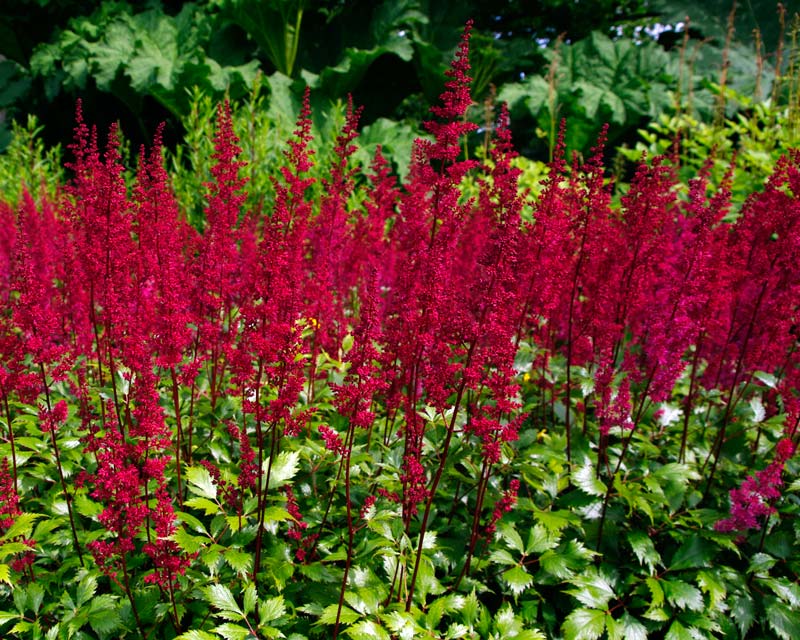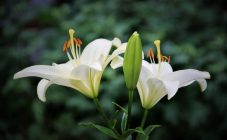Content:
Astilba is a long-flowering perennial unpretentious plant of the Stonefragment family. It takes pride of place among landscape design specialists and summer residents. Up to 200 varieties are known (tall, dwarf, midget, hybrids). They are different in color (from white to crimson) and shape (density of inflorescences, structure of leaves).
Description of the plant
There are varieties according to the flowering period:
- Early flowering - bloom in late June and early July;
- Mid-flowering - in July;
- Late blooming ones - in August.
The following groups are distinguished by the shape of the inflorescences:
- Pyramidal - branches grow from the main axis at right angles and thin from the base to the top;
- Rhombic - lateral branches grow from the main axis at an acute angle;
- Paniculate - lateral inflorescences have multiple ramifications, branches grow from the main axis and taper towards the top. Typical for Arends variety;
- Drooping - inflorescences with flexible branches, characteristic of the varieties Thunberg and Lemoine.
The birthplace of flowers is Japan. The length of the plant is from 15 cm to 2 m.
The varieties that are the most resistant to pests and are distinguished by decorative qualities:
- Arends - grows up to 1 m, rich color palette, blooms in July and August;
- Chinese - reaches 1 m, varied in color;
- Japanese - grows up to 80 cm, a varied palette;
- Thunberg - over 1 m high, rich in color palette.
Why transplant astilba
To admire the color palette, you need to know how and when to transplant astilbe.
Astilba can grow in one place for up to 10 years. Transplanting is necessary due to the specifics of the plant - over time, the roots grow upward (4 cm grows in 1 year), as a result, they may suffer from heat or frost. So, after 3-4 years, the bush begins to fade gradually, flowering becomes scarce, the shrubs lose their splendor. Over time, the plant's vegetative buds die off. Astilba transplant should not be postponed, as it may die.
Repotting is also necessary when the soil is depleted.
Astilba transplant when is better
To grow gorgeous lush flower gardens, you need to know when to transplant Astilba to another location.
Florists are advised to rejuvenate the culture in spring or autumn, because astilba needs a moist environment. Early varieties are transplanted in late August or early September, as there is no hot weather during this period.
Perennials that bloom in the second half of summer are transplanted in the spring. For flowers to take root successfully, they need to provide sufficient insolation and a humid climate. Astilba transplanted in spring will bloom in a month and a half, in June.
With proper adherence to the timing of the transplant, the plant will have enough time to take root and please with flowering.
When to transplant astilba: in spring or autumn
Florists believe that the autumn astilba transplant is the most effective.
The beginning of September or the end of April are favorable periods for flower rejuvenation. In the fall, astilba is transplanted after flowering, a month and a half before the first frost.You can see the first flowers next year.
If you transplant astilbe in the spring, you can admire the first flowering in the summer. The optimal period for a spring transplant is after the end of frost.
Also, the planting time of astilbe varies from the climatic conditions of the region.
How to plant astilba and when
Astilba is a crop that can be replanted throughout the season. In the summer, the bush is transplanted in case it clogs neighboring plants. In this case, the process itself is carried out together with a clod of earth. After replanting the plant, you should ensure abundant watering.
For transplanting flowers, you should choose a shady place, preferably on the north side of the site, next to a reservoir. It grows on almost any soil, it takes root especially well on loam.
Prepare the site before planting. To do this, the soil must be loosened, weeds are weeded, moistened and fertilized (with rotted manure, ash, humus). Planting holes are dug at a distance of 30 cm and a depth of 20 cm.
After planting, the roots are covered with earth and tamped so that air layers are removed. Then abundant watering is required. The roots are sprinkled with mulch on top, which helps the plants survive frost and drought. In hot weather, mulch does not allow moisture to evaporate quickly.
How to transplant astilba? The bushes are propagated by two methods: seed and vegetative. An easier method is transplantation using divisions. The root should be divided so that there are at least 4 buds on each piece. You need to cut the roots with a sharp object so as not to harm the plant. Young bushes are easily divided by hand. Next, the roots are planted in the prepared soil at a distance of 30 cm. With a dense planting, the plant does not bloom well, and the leaves do not grow.
When astilba is propagated by the seedling method, varietal characteristics are not always preserved. In March, seeds are sown in a nutritious substrate. After the appearance of the third leaves at the sprouts, they are dived one by one into separate cups. They are planted in open ground in May. The seed propagation method is usually used by breeders to obtain new plant species.
After planting flowers, the soil should be weeded regularly. With the growth of astilba, the need for weeding gradually disappears.
Tips & Tricks
- The plant actively grows in one place for up to 5 years, then begins to gradually fade;
- You can transplant the bushes not only in spring or autumn, but also in July (if necessary);
- Bush reproduction is the main reason for the autumn transplant. Experienced summer residents in the fall plant astilba by the seed method;
- The place of root division must be treated with ash to prevent decay;
- The first year after transplantation, the plant is weak, therefore, peduncles should be removed to strengthen the roots;
- The main feature of astilba is the growth of roots in the upper soil layer. In summer, water the plants often and abundantly, adding a thick layer of mulch in advance. In addition to mulching, hilling protects the roots of the plant;
- In autumn, the above-ground part of the bush should be pruned, leaving cuttings 3-4 cm in size.It is necessary to add mulch to protect the roots from frost.
With the help of flowers, you can form a variety of compositions. The plant sets off lawns and needles. Landscape designers are actively using astilba in parkland.















